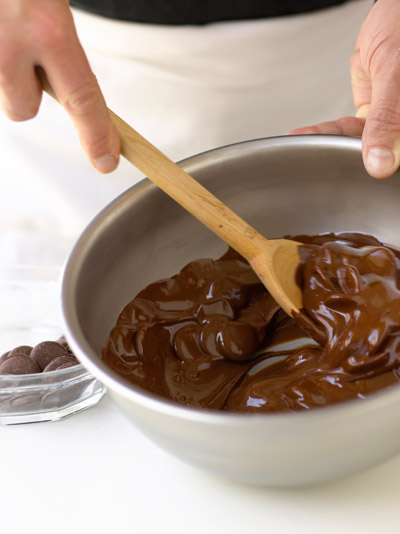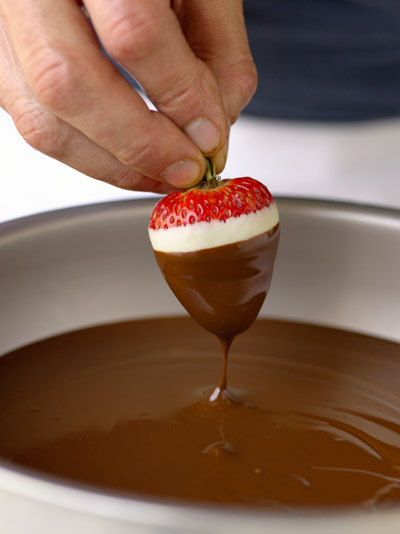Chocolate-Dipped Anything
We can all agree that there are not many limits on what you might consider suitable to dip in chocolate. This Valentine’s Day, create your own fun and romantic dessert of sinful indulgence. Strawberries, dried fruit, and pretzels are traditionally dipped in chocolate, but tradition is made to be broken. Put together your own vision of luscious, chocolate-dipped bits and pieces. Pears are superb dipped in dark or milk chocolate, and pineapple mixes well with milk chocolate. With one taste of the decadent morsels you prepare, your sweetheart is guaranteed to melt.
“Tempered chocolate is the preferred ingredient for dipping,” says The Culinary Institute of America Chef Peter Greweling. “Many home candy makers are intimidated by the thought of tempering chocolate. In truth, the process is much simpler than getting behind the wheel to drive. With just a little practice and patience, you can use the seeding method below to properly temper chocolate every time.”
Tempering Chocolate
- Weigh or measure chocolate you will be tempering. As always, weight is the preferred method for measuring any ingredients; otherwise, use the following chocolate conversion table:
- 6 ounces = 1 cup pistoles* or chopped chocolate, ½-inch pieces
- 8 ounces = 1 ⅓ cups pistoles or chopped chocolate, ½-inch pieces
- 10 ounces = 1 cup melted chocolate
- 8 ounces = ¾ cup melted chocolate
- Weigh or measure second amount of chocolate equal to 25 percent of original amount.
- Fully melt larger amount of chocolate using microwave or water bath. Remove bowl of melted chocolate from heat. Chocolate should be 120°F for dark chocolate or 110°F for milk or white chocolate.
- Add smaller amount of unmelted chocolate to melted chocolate. This is called the seed; it will cool the melted chocolate and cause it to set the way you want. You can use either pistoles or a single block as the seed; a single block has the advantage of easy removal once the chocolate is tempered.
- Stir melted chocolate gently and constantly until temperature falls to 85°F for dark chocolate or 83°F for milk or white chocolate. This will take 15 to 20 minutes, and most or all of the seed should have melted by the end of this time.
- Testing chocolate for temper is the only way to know for sure that chocolate is actually tempered. The following temperatures give good guidelines, but even with strict adherence to technique, no one can tell for sure whether chocolate is tempered without performing a test to see how it sets.
- Make sure chocolate is below 90°F for dark or 87°F for milk or white chocolate.
- Dip spoon in chocolate, place spoon on work surface, and leave it undisturbed for 7 to 8 minutes at working room temperature, 68°F. Do not yield to the temptation to refrigerate the spoon! This will only give inaccurate results.
- After 8 minutes have passed, look closely at the chocolate on the spoon. If chocolate has set so that it no longer looks wet, and surface is uniform and without streaks, chocolate is tempered.
- If chocolate has not set or has set with a streaky appearance, chocolate requires further seeding (see step 8).
- If chocolate sets properly, gently warm it over water bath not exceeding 89°F for dark chocolate or 86°F for milk or white chocolate.
- If seed has melted but chocolate is not setting quickly without streaks or spots, it must be seeded more. Add a few more pistoles or another small block to bowl, and stir for another 3 to 4 minutes. After this time, test again (step 6), and proceed from there.
- Remove any unmelted seeds from melted chocolate.
- Use chocolate as desired while maintaining the proper working temperature.
How To Dip
- Prepare the centers. The centers to be dipped should be dry and at a cool room temperature. When dipping fruit in chocolate, allow it to warm to room temperature rather than dipping it while it is ice-cold from the refrigerator. If cutting fruit for dipping, dry the cut pieces with a paper towel to remove excess moisture from the surface of the fruit.
- Temper the chocolate or melt the coating. Dipping centers in untempered chocolate will result in bloom and chocolate that is not sufficiently crisp. If using a compound coating, follow the manufacturer’s guidelines for temperature.
- Dip the centers. The centers may be entirely enrobed in the chocolate by dipping with a fork, or partially coated by holding one end of the center and dipping up to the desired level in the chocolate.
- Allow the chocolate to set. Placing the dipped centers on parchment paper to set keeps them clean and ensures that they will not stick to the surface. This step should always be performed at room temperature to obtain the best shine and snap from the chocolate.
*Pistoles
Discs of couverture, which is chocolate made from cacao beans that have been fermented and dried properly then roasted, refined, and conched to improve flavor and texture.
Recipe, photos, and video courtesy The Culinary Institute of America. All rights reserved. You can find this recipe and more in The Culinary Institute of America’s Chocolates and Confections at Home (2010, John Wiley & Sons Inc.).
Your Future in Chocolate
Walking through the candy aisle at your local supermarket, you might be tempted to think the chocolate industry is simply flooded. Surely there is no way to expand on the already numerous options.
But you would be wrong, very wrong. No dip in the economy is going to melt this ever-inventive industry as it continues to meet chocolate-buyers’ concerns over environmental and social-justice issues.
We may see several new types of chocolate in the coming year:
- Single-origin chocolate, which is made with cacao exclusively from one region (Ecuador, Peru, Costa Rica, Madagascar, etc.)
- More organic chocolate, which uses beans grown to organic standards, using no pesticides or harmful toxins.
- Fair-trade chocolate, which ensures that cocoa growers get fair prices and fair treatment for their beans.
- Sustainable chocolates, which are grown with methods that ensure sustainable re-growth of cocoa beans
Finally, a responsible way to enjoy chocolate.
With so many chocolates to choose from, it’s no wonder chocolate pairings are becoming the new wine tastings. Companies are starting to test unexpected pairings of chocolate with wines, cheese, spices, exotic flavors, and fruits not used in the past.
Appealing to the students of chocolate, who are engaged in a life-long course of study, several retailers and restaurants have begun chocolate tastings and chocolate schools. Café Zooka in Hershey, Pennsylvania offers courses to educate visitors on chocolate as well as chocolate tasting. Ethel’s Chocolate Lounges (see link below) have added tastings to some of their stores in Illinois and Nevada.
Chocolate companies see a promising opportunity in this field. In the coming years, the industry is expecting an explosion of this kind of offering. For consumers, it is a fun and educational way to taste chocolate.
In 2009 the National Confectioners Association came out with a report showing that it believes future trends with chocolate will capitalize on health benefits, flavor fusions, and international influences. Flavor fusions use ingredients that unexpectedly complement each other, such as milk chocolate, caramel, and sea salt. Another potential is the fusion of exotic spices. International recipes are experimenting with the combination of chocolate and chilis or chocolate and wasabi.
Long gone are the days when your only options for chocolate came at the vending machine. Consumers are beginning to demand more from their chocolate experience. Chocolate makers are looking to meet your needs and offer ways to make chocolate even more appealing—if that’s even possible.
For more information on the sources presented here please see:
The National Confectioners Association
http://www.candyusa.com/News/PRdetail.cfm?ItemNumber=1456
The Gourmet Retailer 2008 Trend Report
To see more about the tasting or educational opportunities listed please see:
Hershey
http://www.hersheystory.org/education/
http://www.hersheystory.org/chocolate-tasting/
Ethel’s Chocolate Lounge
http://www.ethelschocolate.com/
Chocolate Is Here to Stay!
In the late 19th century, a man by the name of Milton Hershey bought a new technology to help him produce a chocolate coating for his caramels. What Hershey could not have known was that this new technology would be his “bread and butter,” not his caramels. Within a few years, he made this keen observation: “Caramels are only a fad. Chocolate is a permanent thing.” In 1903, Hershey began the Hershey Chocolate Company and began a chocolate revolution in the United States. Through his methods of mass-production, he was able to lower the cost of the chocolate and make it an affordable luxury item.
Over a century later, chocolate is still a “hot topic.” In recent years, chocolate as an industry has even seen a rebirth. Instead of mass-production and affordability, chocolate has moved into niche markets as a diet and health food, a delicacy to accompany wines and cheese, and a mood-enhancer. Mass-produced chocolates are still highly popular, but a growing number of chocolate lovers are finding pleasure in these new offerings.
Here at the Post, we have a variety of chocolate lovers. We thought our readers would enjoy a series of postings that look at the history and the future of chocolate!
Let’s begin with a brief introduction to the key terms:
Cacao (%): The term refers to the ingredients derived from the cocoa bean. The source of the cacao components are “chocolate liquor” — the term used to describe the pure (nonalcoholic) chocolate in liquid form, cocoa butter, and cocoa powder. The” % cacao” refers to the percentage of these ingredients, by weight, in the finished product.
Dark Chocolate: The term “dark chocolate” is not defined by regulation in the US. Within the industry however, it is used to refer to both sweet and bittersweet chocolates containing high levels of chocolate liquor. Many dark chocolates on the market today contain more than 35% chocolate liquor. It is common to see dark chocolates containing 45-80% cacao on the market today. Dark chocolates may contain milk fat to soften the texture, but do not generally have a milky flavor.
Milk Chocolate: The most common kind of eating chocolate; it is made by combining chocolate liquor, cocoa butter, milk or cream and, sweeteners such as sugars and flavorings. According to the FDA regulations, all milk chocolate must contain at least 10% chocolate liquor and at least 12% milk solids. The only fats allowed in milk chocolate are milk fat and cocoa butter. The varieties of milk chocolates in the market are expanding. Some high cacao % milk chocolates are essentially dark chocolates with additional dairy ingredients.
White Chocolate: White chocolate is a blend of cocoa butter, milk, sugar, and flavor. No chocolate solids other than cocoa butter are present, which explains the lack of brown color. According to US regulations, white chocolate needs to be at least 20% (by weight) cocoa butter, at least 14% total milk solids, and less than 55% sweeteners (such as sugar.)
Please join us over the next few Fridays as we explore chocolate. Our chocolate postings will help you determine which chocolates you like, and encourage you to try something new.
More chocolate information may be found at the National Confectioners Association website – www.candyusa.com


